|
Portable Pastimes
by Betty Minaker Pratt and Bill Pratt

|
|
Suitcase portables
|
|
|

|
|
Miniatures and other suitcase models
|
|
|
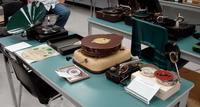
|
|
Unusual portables
|
|
|
One of CAPS' most popular meetings is its annual exhibit of phonographs and gramophones from members' collections.
The September 17, 2006 meeting featured a superb selection of portable talking machines whose range and condition,
from an 1898 Edison Standard, perhaps the first mass-produced "portable", to a 1954 HMV 102, made a spectacular display.
CAPS members who contributed machines are Mike Batch, Mike Dicecco, Saul Glass, Brian McAlpine, Ed Moran, Paul Parsons,
John Peel, John Rutherford and Don Scafe. Other members kindly provided much useful information for this article -
Domenic DiBernardo, Horst Weggler and Arthur Zimmerman.
The descriptions in this photo essay come primarily from the owners’
observations of their machines, with additional research from various sources to help us to define and date these portables.
The first disc-playing portables, suitcase-style machines such as the Decca, were introduced during WWI for use by
the military in the field. By the early 1920s, and continuing throughout the decade, novel portables from many manufacturers
were advertised extensively, ideal for use on picnics, camping, and boating. Also introduced in the 1920s was a wide
range of ingenious miniature machines, often using Swiss-made motors.
Group 1: Cylinder Player
Edison Standard

|
|
Square-top Model A Edison Standard (Don Scafe)
|
|
|
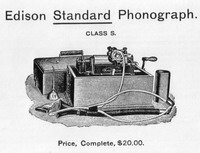
|
|
1898 advertisement for the Edison Standard
|
|
|
The first machine in the exhibit, a square-top Model A Edison Standard, introduced in 1898, is not strictly a "portable".
Collectors generally use that term for disc machines from WW I through the 1960s. Virtually all table-top cylinder players,
however, were meant to be portable.
The Standard was Edison's earliest portable model for the mass market and the least expensive,
initially selling for $20.00. Until the introduction of the smaller and less expensive Gem, this was Edison's most popular and
successful model. It was also the first machine Don Scafe ever bought, and it launched him into the hobby of phonograph collecting.
Group 2: Miniatures
Peter Pan

|
|
Peter Pan (John Peel)
|
|
|
Disguised as a black box camera, the Peter Pan used a Swiss-made motor and was assembled in England. It has a
copy of the Victor Exhibition soundbox with a mica diaphragm marked "Peter Pan" and a tapered tone arm with a
Victor-type U-joint. The original version of 1922 had a telescopic tone arm, but the Improved Peter Pan of 1924
used a conventional tone arm. In 1923 it was sold by the Peter Pan Gramophone Ltd of Gerrard St. and Frith St.
London. The soundbox is marked in red "Peter Pan / Brevete S.G.D.G. Swiss Made / Brevete Dans Tous Les Pays Du Monde".
Brevete translates as Patent, and S.G.D.G. stands for Sans Garantie du Gouvernment.
The Peter Pan in the authors' collection has a French Ivory label marked "Peter Pan Gramophone, Patent Nos. 226015 - 705313 /
And Additional Worlds Patents Pending". Another label, displayed on a Peter Pan at the September 2007 meeting, had Patent Nos. 15825/23 – 705313.
Windsor Main Springs catalogue, dated Fall 1929, (authors' collection), distributed by Berlind Phonograph Co.,
Montreal, lists the size of the spring for the Peter Pan as "25/32 x 0.025 inches x 8 1/2 feet ... special pear-shaped holes ... 40 cents."
Cameraphone

|
|
Detail of Cameraphone soundbox (John Peel)
|
|
|

|
|
Cameraphone (John Peel)
|
|
|
There were three models of Cameraphone, in oak, mahogany and deluxe leather. The turntable and parabolic sound
chamber were patented in 1923 by E.C.R. Marks, and then J. Weiss & Co. (A. Thompson, p. 9).
This is an unusual model of the Cameraphone with a simulated tortoise-shell resonator or egg as the soundbox.
John Peel found that inside the egg there is a little elbow, like an old French telephone. The diaphragm is
labeled "Cameraphone / Will Play any Record/ Made in England". The motor was probably made in Switzerland.
It was sold in 1924 and 1925 at two addresses by Cameraphone Co. Ltd, 11 Finsbury Park, and by Lee & Pollock,
Finsbury Square, London, priced between £3 3s and £4 10s.
Mikiphone

|
|
Advertisement for the Mikiphone, August 1926
|
|
|
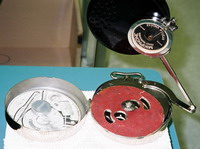
|
|
Mikiphone (Paul Parsons)
|
|
|
Paul Parsons found on the case and reproducer of his Mikiphone – "Mikiphone Pocket Phonograph / Swiss Made / System Vadasz".
The Brothers Vadasz obtained a British patent in 1924 for this gramophone housed in a watch case. There were between
100,000 and 180,000 units manufactured between 1925 and 1927.
Mike Bryan has seen red and blue colours around the embossed letters on the lid, though these applied colours often wear off.
The label on Domenic’s Mikiphone, with blue lettering around central red words, also says "Patented in All Countries".
The plastic resonator is mounted directly to the soundbox, and has a fixed watch-like winding key. The small turntable,
3.9 inches in diameter, will play 10- or 12-inch records, which are held in place by a single screw.
The Mikiphone has a nickel-plated case, 4 1/2 inches in diameter. Fabrizio & Paul's Phonographs With Flair, pp. 88-89,
adds a soft leather carrying case with a zipper, and Eric Reiss, p. 197, shows it with a rigid leather case.
Excelda

|
|
Excelda (John Peel)
|
|
|

|
|
Excelda soundbox (Horst Weggler)
|
|
|
Thorens began making music boxes and clock movements in 1883, and started producing Edison-type phonographs in 1903.
In 1928, they made an electric record player and still make high-end audio equipment today. Keith Wright's web site illustrates that Thorens made other portables
such as a wooden table top disc machine dated 1925. Keith also shows that the miniature Excelda imitated the Kodak 'Autographic' folding bellows-type camera of 1914-1932.
http://keithwright.ca/Thorens/Thorenspage.html
The Excelda was introduced in 1931 (A. Thompson, p. 10). On another website
http://www.grammophon.ch/weltemignon.ch.htm
the Excelda is dated 1930 to 1945. In V. De Caluwe, p. 145, an Excelda model is dated 1947.
Stamped "Excelda" on the handle, the diaphragm is marked "Thorens Swiss" with the anchor trademark.
The Excelda has an oversize crank and should be wound only on the edge of a table. Its spindle has a nut to secure
the record on the platter. The crackle enamel case also came in black, red, blue, grey, tan and green. Domenic has
a blue Excelda marked "Thorens / Made in Switzerland" on an oval plaque. The brake and speed control have a push-up
or -down lever at the back. John’s example has a plate with "British patent No. 255001".
The soundbox on Horst Weggler’s red-cased Excelda is marked "Thorens" and "No. 17". The dealer’s label on this
gramophone shows "Abercrombie & Fitch / New York / Made in Switzerland". Since 1892, Abercrombie & Fitch of Great
Britain outfitted celebrities for hunting expeditions, such as African safaris.
Colibri

|
|
Colibri soundbox (Domenic Dibernardo)
|
|
|

|
|
Colibri (Mike Dicecco)
|
|
|
The Colibri was introduced about 1928-1930 and has a Swiss-made motor and a special sound chamber in the lid.
When the machine is unfolded and the telescoping tone arm is assembled, a spring-loaded panel rises automatically to
create a baffle. It can play 12-inch records.
Horst Weggler has a Colibri showing the trademark "Fabrication Belge" on the outside of the black case.
Dominic Dibernardo’s has a completely nickel-plated case, with "Fabrique En Suisse" on the reproducer, and
"Fabrication Belge" engraved inside the lid. Both have leather strap handles on the front of the case, each attached differently.
A photo on this website shows a carrying case for a Colibri.
http://www.oneillselectronicmuseum.com/largephotos/phono/colibriportclsd.jpg
A Colibri in the Powerhouse Museum, Sydney, Australia is dated to 1930-1939.
http://www.powerhousemuseum.com/collection/database/?irn=247153
Mike Bryan visited a phonograph museum in Les Gets, France, near Lake Geneva, which might provide
further information on the source of Colibri motors – see http://lemuseedesgets.free.fr/
The Music Box Society (MBSI) lists eight possible musical instrument factories in Belgium. For instance,
Pierre Eich of Ghent might be a source of phonograph motors – see http://www.mbsi.org/manufacturers.php
Group 3: Suitcase Models
Paillard

|
|
Paillard, brown (Ed Moran)
|
|
|

|
|
Paillard, black (John Peel)
|
|
|

|
|
Paillard trademark label (John Peel)
|
|
|
Paillard of Sainte-Croix, Switzerland, made music boxes from 1814, then cylinder phonographs from 1898.
In 1904 they began making disc gramophones, and in 1910 brought out the Maestrofone, which ran on hot air.
Paillard Bolex cameras are still available today, and their Hermes typewriters were made until the
1960s (A. Thompson, p. 9).
The soundbox on John Peel's black Paillard, with an aluminum diaphragm, displays "Maestrophonic S 18 / Fab. Suisse".
No. 301 is stamped on the inside rim of the case, in front of the speed control. The folding crank doesn't detach,
and the 9-inch turntable is capable of playing 10-inch records. It has a single spring, 3 1/2 feet x 3/4 or 7/8 inches wide,
which plays one record safely. The speed control lever says "Presto" on the left side, "78" in the middle, and "Lento" on the right.
After removing five screws, one can see serial number 2465865 on the plate at the bottom of the motor, inside the case.
Also inside the case there is a circle with letters around the rim, stating "Fab. Suisse / Made in Switzerland / Paillard".
Model "No. 175" is written at the bottom of the motor.
HMV 101 and 102

|
|
HMV 102, blue (John Rutherford)
|
|
|
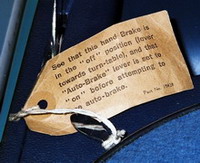
|
|
HMV 102 hand brake shipping label (John Rutherford)
|
|
|
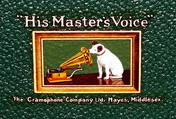
|
|
HMV 102 trademark label (Ed Moran)
|
|
|
Dave Cooper’s book has a good review of these models, giving soundbox and motor numbers with the corresponding production dates.
Dave describes all changes to parts such as escutcheons and cranks. Locks, catches and handles were supplied by other companies,
such as Beddoe & Cheney.
He describes the first portable HMV in oak which appeared in 1920. HMV model 100 was available between June 1924 and October 1925.
HMV 101 was introduced in 1925. The winding handle, originally in the front, was moved to the side in early 1927. Model 102 came
out in 1929, phasing out the 101 completely by July 1931. There was a complicated Universal braking system in 1931, which was
replaced by a simpler version by the end of 1932. The HMV portable 102 models were made until 1960, then after that they were sold from
stock. Similar models up to No. 303 were made until the late 1950s.
John Rutherford’s blue portable is in amazing condition, plays very loudly and still carries its two original shipping tags
attached with string - one for the "Hand brake ... Auto Brake ...", and the other "Final inspection O.K ... Please Quote Both
Model and Serial No ...". The serial number is B/18 144401 / LBB 102 E. "The Gramophone Co. Hayes, Middlesex. / Made in Great Britain"
appears on the label under the lid. It has a 5B reproducer with an aluminum diaphragm, a single 1-inch x 14-foot spring, and a 10-inch turntable.

|
|
HMV 102, black, with record tray (Saul Glass)
|
|
|

|
|
HMV 102, black, Auto Brake label (Brian McAlpine).
An additional tin label under the lid describes the use of the Auto Brake.
|
|
|

|
|
HMV 102 key (Ed Moran)
|
|
|
Production of HMVs was curtailed during WWII; then the 102 E was available in September 1950, (Dave Cooper, p. 68).
Dave was kind enough to reply by email about John’s serial numbers, saying "the year can be worked out by using the B code.
B was used in 1936, B1 = 1937, B2 = 1938 etc. So, John’s machine is a later 102, made around 1954."
Ian Calderbank's website explains that coloured portables are rare. Now sought after by collectors, the HMV 102 cost
40 pence more at the time for a red, green or blue case.
Saul Glass’ black HMV 102 has a record carrier, introduced in 1931. It displays a small label under the turntable
indicating Model No. 102. It has an Orthophonic soundbox and single-spring motor. Saul reports that it sounds very loud when played
with a Loud Tone needle. Ian Calderbank states that record trays are often lost, making this example very collectible.
Since HMV dispensed with the record tray by 1936, Saul's machine can be dated between 1931 and 1936. This machine,
in immaculate condition, is complete with its original key. At the front corners of the case, a plastic shelf pivots to open,
holding needles or keys, whereas earlier coloured HMVs had chrome needle drawers. An embossed trademark Nipper on the back
of the soundbox is often visible.
Decca

|
|
Advertisement for the Decca portable, circa 1919, Punch
|
|
|
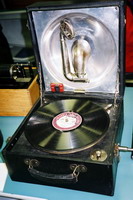
|
|
Decca (Don Scafe)
|
|
|
Made by Barnett Samuel & Sons Ltd, England, and introduced in 1914, the Decca Dulciphone was the first suitcase-type portable.
Its popularity during the Great War earned it the name "Trench Decca". From the early part of the 19th century, the Samuel
company had imported whole music boxes or their parts for assembly from Germany and Switzerland, and later complete phonographs
and parts. In 1929, the company became Decca Gramophone Co. Ltd. Later, Decca Records Ltd became the largest record label in the world.
Toronto Star advertisements for Decca portables (163 1/2 Church Street), started Friday, May 21, 1920, p. 5. They were
described as 11 1/2 inches square by 8 inches high, and weighed only 13 pounds. "Though small, the Decca is as loud, as rich in tone,
as clear ...as the most expensive phonograph...Plays all makes and sizes of needle records...The Decca’s greatest reputation was
made in France ...in use during the War amongst Canadian and British troops." It was offered in black leather cloth, in brown
compressed fibre and the most expensive, in brown cowhide, cost $75.00. The vast majority of surviving Decca portables
were made well into the 1920s.
This portable is labeled "Dulciphone", and it has a double-spring Swiss motor and Swiss soundbox. The Thorens, St. Croix,
Switzerland trademark, of an anchor in a cross, was stamped on the top exposed plate of the motor. Decca never made their
own motors or soundboxes. The deep lid contains a mirrored-finish metal bowl called a "Dulciflex" which reflects sound from
the machine with remarkable volume. After WWI, modifications were introduced such as strut hinges to support the lid, instead of chains.
The smaller Decca Junior was offered as early as 1924. Domenic’s Junior has "RD 631877 / Patent 3033" on the tone arm.
Various other models were made into the 1950s.
Bell

|
|
Bell (Don Scafe)
|
|
|
Schubert-Bell Talking Machine Corp, of 1 West 139th St. New York, filed a trademark on June 25, 1917. Bell
Record Corp. produced records for Schubert, then launched their own Bell Record label about 1920. They used
masters from Emerson, and then shifted to Gennett. The Bell label went out of business in 1928. We can’t verify
that the "Bell" shown here is from this same company, until we acquire pictures from original ads or trade literature.
This portable has a Swiss-made Thorens 2-spring motor. Stamped on the back of the reproducer
are the words "Swiss Made", and a serial number "594388" appears at the
base of the tone arm. The horn, contained within the case, is made of fibre
and is attached to the tone arm. A flexible head allows playing both lateral and vertical-cut records. Inside the lid,
with the "Bell" trademark, is a place to store the crank and a container for needles. The locks on the suitcase are
stamped "Eagle Lock Co., Terryville, Conn., U.S.A.". Eli Terry of Connecticut was a famous clockmaker, and his son started the lock company in 1854.
Carryola

|
|
Carryola (Don Scafe)
|
|
|

|
|
Carryola Flapper trademark label (Don Scafe)
|
|
|
Steve Daily, Curator of Research Collections of Milwaukee County Historical Society, determined from local
City Directories that Carryola Company of America was in business from 1924 to 1928. "They had locations at 373 Broadway
and 647 Clinton St." Milwaukee.
Ads from Talking Machine World magazine of July 1924 show a traditional suitcase-style Carryola portable. Suitcase Carryolas
appeared in the Toronto Star from July 29, 1926, p. 2. They had a "fabrikoid" leather cover in red, blue, green or black.
The Star stated that the tone chamber was equivalent to a large upright. It had a "Carryola Master /
Add-A-Tone" reproducer which gave necessary volume for outdoors. "Master" Carryolas were seen in the Star until May 30, 1929, p. 5. The 1929
Windsor Main Springs catalogue describes other Carryola models such as The Carryola Cub, Carryola Ace, and new Carryola Master.
Only one ad for the "Flapper" appeared in the Toronto Star, June 16, 1927, p. 5. It was offered by the Adams
Furniture Company (211-219 Yonge St.) for $24.75, less than the regular price of $41.25, including 10 records.
This one was offered in black with brown leather trimmings.
Made in Milwaukee, Wisconsin, this unusual round-cased portable is labeled "Master Portable Phonograph" and has a "Carryola Flapper"
trademark. The 16-inch round case with handle has one flat side in order to allow it to sit upright. It has a black-grained
leather cover with blue lining, two clips to hold the lid closed and a separate lock. A cloth pocket on the inside of the lid
holds 78 RPM records. In remarkable condition, this portable still has its original cleaning brush, guarantee card and instruction sheet.
Columbia

|
|
Columbia Model 163 Viva-Tonal (Mike Batch)
|
|
|
In February 1925, Columbia began recording with a new electric process called Viva-Tonal.
R. L. Passerieux of E.M.I. Records, Head Office, Hayes, England mailed a letter to CAPS member
George Wonch, Aug. 18, 1966 (courtesy Horst Weggler): "Columbia Viva-Tonal Grafanolas were first introduced in 1927.
The portable Model 112 or 112a....priced at £4.15 and £5.10 respectively. Model 112 was the standard one, and Model 112a
was covered in what is described as crocodile cloth...." "Model 117a, Oak, Small Table Grand, £6.10 / Model 118a, Mahogany,
Small Table Grand, £7.10 / Model 119a, Oak, Standard Table Grand, £8.10 / Model 120a, Mahogany, Standard Table Grand, £9.10....
All these models date from 1929 and were available until about 1936. Columbia Grafonola Favorites Electric Repeat and
Clock Spring (spring wound) was introduced in 1925."
Columbia ads begin in the Toronto Star July 4, 1930, p. 5. There is an illustration Tues., Feb. 21, 1933, p. 15
stating "Simpson’s purchased the Maker’s entire stock.... These fine instruments have lovely tone and all the latest improvements."
A regular $35 model was now less than half price at $14.95, and the $45 model sold for $18.95 (Robert Simpson Co. Ltd., Sixth Floor).
The patents on Mike Batch’s Model 163 Columbia Viva-Tonal date it after 1926: "Columbia Phonograph Company Incorporated New York U.S.A." / "Viva-Tonal
Columbia / Like Life Itself". The label, gold-printed on wood, reads "Graphonola / Made and Patented in U.S.A / Patented in foreign
Countries / All have marks reg. U.S. Pat. of M.R.M Regrada Nos. Marca Industria / Registrada 8 ago. Nos 1696 2648 Y 2672 MODEL 163
8423 Y 18426 DE 6 DE August O 1920 / Y 26088 De. 23 August O 1926".
The sound box is marked "Columbia Phonograph Co. Inc. New York U.S.A". This model has the tone arm at the back, not at the front as some books illustrate.
Arthur Zimmerman has a British-made Columbia 100 (Cadet), with an original sound box, Model 15a. The black,
crackle-finish metal case is more compact than the Viva-Tonal, measuring 8 13/16 inches wide x 12 12/16 inches long x 7 1/16 inch high,
with a little hump in centre of the lid.
Unidentified Portable

|
|
Unidentified portable (Don Scafe)
|
|
|
"Made in Germany" is stamped on the back of the reproducer, but there are otherwise no identification marks on this black,
leatherette-covered suitcase-style portable. The tone arm folds, and there is a brake to the left of the turntable.
The speed control is on the front of the case beside the lock. A door on the front folds down to release the sound from
the internal horn. This machine was found at the Odessa, Ontario, antique sale. If anyone can identify this model,
please let us know.
Group 4: Unusual Portables
Stewart
In 1893, John K. Stewart and Thomas Clark started manufacturing drive-shafts, sheep shears, horse clippers,
and bicycle handle-bars in Chicago. Then they expanded to speedometers for Model T Fords. They bought the Warner
company in 1912, and by 1916 Stewart, who loved music, had established a phonograph factory in Chicago. A trademark
was filed for the Stewart Phonograph Corp at 2827 N. Lincoln St., Chicago, Il., November, 1916 (R. J. Wakeman).

|
|
Advertisement for Stewart phonograph, Toronto Star, May 10, 1920
|
|
|

|
|
Stewart in original carrying case (Don Scafe)
|
|
|
Stewarts were manufactured in Toronto as well as in Chicago. A corporate file at the Ontario Provincial Companies Branch
indicates there was a separate Canadian company established in Ontario. The pamphlet included with this Stewart shows a Toronto
address, probably for the showrooms at 1110 Temple Building, erected in 1896 at Richmond and Bay Street, one of the first
large skyscrapers built for the Independent Order of Foresters. There are ads for Stewart in Eaton’s catalogues of 1919, 1920, and 1921.
Another ad appeared in the Toronto Daily Star, May 10, 1920 showing an asking price of $15.00.
The 1920 Might's City Directory shows Stewart Phonographs as distributors, on Pape Ave. Theodore Vatcher was manager at Pape Ave.
in 1922, and Earl M. Jones, manager in 1923. "During these years the firm used the premises of W. H. Banfield & Sons Ltd.,
manufacturers of lighting fixtures and phonograph motors, 370-386 Pape Ave." (Letter from Toronto City Clerk answering George Wonch,
Aug. 30, 1966; courtesy Horst Weggler).
The Globe, Sept. 1, 1920, p. 11 stated that Banfield purchased an entire plant from the U.S. and moved it
to Toronto. In 1916, during WWI, Banfield made fuses and munitions, and by 1929 they consolidated three electrical equipment companies
making switches, outlet boxes, and wiring (Toronto Star, March 20, 1929, p. 13).
The company later became Stewart-Warner and continued to make televisions, radios, and speakers. Stewart-Warner
speedometers were also sold in Toronto (265 Church St.) and across Canada [Pamphlet in the authors’ collection].
Labelled "Stewart Phonograph Corp. Ltd Toronto Canada" this is a mahogany-lithographed tin-plate model with a carrying case.
On top were nickel trimmings. It has a single-spring motor, a 10-inch turntable and can play two records with one winding.
The reproducer pivots forward to play vertical-cut discs. Mike Bryan believes the mahogany case was typical of those made
in Toronto, whereas the green or cream probably came from Chicago. Domenic Dibernardo has a gold-coloured case.
The Windsor Main Spring catalogue lists a spring suitable for Stewart at 1 x 0.025 inches x 9 feet, with pear-shaped holes at 50 cents.
Polly Portable

|
|
Polly trademark label (Domenic Dibernardo)
|
|
|

|
|
Polly Portable (Don Scafe)
|
|
|
The trademark label reads "Polly Portable Phonograph Co., 353 Fifth Avenue, New York". The website of Mainspring Press
says the company filed a trademark for the Polly brand on September 2nd, 1925, claiming use on phonographs and parts
since the month before. They did not mention records, but a rare 78 label with a parrot does exist. The Polly was listed
under the Brunswick name as well.
The reproduction green "oscillator" or cone on this machine folds up to store in the lid. This cone acts like a
conventional tone arm, reproducer and horn. Ed Moran has a cardboard cone horn printed with a basket-weave pattern and a red label,
"Brunswick Balke Collendar Co. / Chicago/ New York / Copyrighted 1927 / Patented Nov. 2, 1915". Six 10-inch records can
be carried on the turntable, which has an extra-long spindle shaft. Original instructions, "How to Operate the Polly" are on
a cardboard disc which, when placed on top of the records, will protect them. An identical version of this portable machine with a
different printed picture on the cone, made in Britain in 1929, is called the Guiniphone.
The Windsor Main Springs catalogue lists sizes for "Polly Portable" and "Brunswick Parisian" springs - 3/4 x 0.024 inches x 18 feet ... 75 cents.
The Toronto Star, Wed., Feb. 13, 1929, p. 5 advertised the Polly at Adams Furniture (211-219 Yonge St.).
It had "a thoroughly reliable motor ... plays all makes of records, either 10 inch or 12 inch, five double sides ... new electrical
process records (giving 10 selections)."
Phonocone
The Phonocone was sold exclusively by Montgomery Ward. The Portelec motors mentioned at
http://www.phonoland.com/archives/mboards/mboards.mv?action=show_message&go_category=EN0000000003&go_msg=0000016291 were made by General Industries of Ohio
and dated 1940-1949. Otto Heineman, president of General Industries, Ohio, and General Phonograph Corp., New York, appeared
in The Talking Machine World, Dec. 15, 1922, p. 93 (courtesy Horst Weggler). From modest beginnings in 1914,
Heineman and Carl Lindstrom of Berlin established factories in the U.S. and Canada. Heineman had phonograph motor and supply
factories in Elyria, Ohio, as well as Toronto, and Kitchener Ontario (Canadian Trade Index, 1920-1924).

|
|
Phonocone trademark label (Domenic Dibernardo)
|
|
|

|
|
Phonocone, open (Mike Dicecco)
|
|
|

|
|
Phonocone, closed (Mike Dicecco)
|
|
|
The "Portelec" motor was produced in the U.S.A. in 1946 as a spring-driven model (The Phonographic Record of New Zealand, April, 1970, Vol. 5,
Issue 4, pp. 29-30). They did make an electrically-driven model with the same sound head. It was the invention of Robert G. Metzner,
who filed at the U.S. Patent Office.
Toronto Star illustrated the Phonocone (July 11, 1946, p. 5 to Jan. 31, 1948, p. 5) priced at $4.95 at Adams Trade-In store.
On Aug. 22, 1946, p. 5, it was available for $24.95, described as "the greatest scientific invention in record players in 20 years".
It had the same speakers as a table radio, and weighed 8 pounds. It came complete with 35 Duotone needles, and measured 13 5/8 inches x 10 1/2
inches x 6 1/8 inches. "This is exactly what you need for your country house, chalet, or student’s room...."
The base on Mike’s Phonocone appears to be crinkled metal, but it is really papier mache. The cardboard top acts as both
the reproducer and horn. Domenic’s "Portolec" trademark label appears on top of the cone, and the label under the base has
"If You write to Us About this Article or if You Order Replacement Parts Always Mention Model No. 64 JPS – 1900B. Order
Replacement parts Through Any of Our Retail Stores or by Mail / Montgomery Ward".
References
- Andre's Phonographen-Kabinett, "Excelda" and "Mikiphone" http://www.grammophon.ch/weltemignon.ch.htm
- Baumbach, Robert, Columbia Phonograph Companion, Vol. II, Stationery X-Press, 1996
- Bayly, Ernie., The EMI Collection, Talking Machine Review, 2nd edition, 1977
- Bergonzi, Ben, Old Gramophones, Shire Publications Limited, 1991
- Calderbank, Ian, "Gramophones" http://www.gramophones.info/gramophones.hmv.102.blue.html
- Cooper, Dave, "His Master’s Voice", The Perfect Portable Gramophone , New Cavendish Books, 2005
http://www.talking-shellac.com/index.html, deejsee@gmail.com
- Daily, Steve, Curator Reasearch Collections, Milwaukee County Historical Society. Letter to Betty Pratt, dated March 28, 2007.
- De Caluwe, Verzameling, Van Muziekdoos, Tot Grammofoon, Stedelijk Museum, Sint-Niklaas, 1979
- Fabrizio, Timothy C. and Paul, George F., Discovering Antique Phonographs, Schiffer Publishing Ltd., 2000
- Fabrizio, Timothy C. and Paul, George F., Phonographs with Flair, Schiffer Publishing Ltd., 2001
- Gracyk, Tim, "Tim's Phonographs and Old Records" http://www.gracyk.com/makers.shtml and
http://www.gracyk.com/companion.shtml
- Jewell, Brian, Veteran Talking Machines, Midas Books, 1977
- Koenigsberg, Allen, "Edison Phonographs... T. J. Moncks, N.Y.", Facsimile Edition, 1973
- Marty, Daniel, The Illustrated History of Phonographs, Dorset Press, 1989
- "Phonographs, Colibri" http://www.oneillselectronicmuseum.com/page6.html
- Powerhouse Museum Collection, Sydney, Australia "Colibri"
http://www.powerhousemuseum.com/collection/database/?irn=247153
- Proudfoot, Christopher, Collecting Phonographs and Gramophones, Mayflower Books, 1980
- Reiss, Eric L., The Compleat Talking Machine, Sonoran Publishing, 1996
- Rust, Brian, The American Record Label Book, Arlington House Publishing, 1978
- Sounds Vintage, Vol. 3, No. 4, July-Aug., 1981, Kent
- Sutton, Allan, "A Polly Record, late 1920s", http://www.mainspringpress.com/lom899.html
- The Phonographic News, Vol. 5, No. 2, South Australia, 1979
- Thompson, Alistair G., Phonographs & Gramophones, The Royal Scottish Museum, 1977
- Wakeman, R. J., "236 Machines and their Makers" http://www.worldofgramophones.com/gramolist.html
and http://www.worldofgrapmophones.com/5gazette042002.html
|